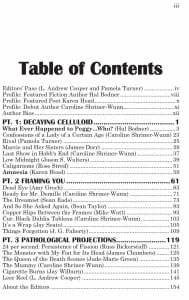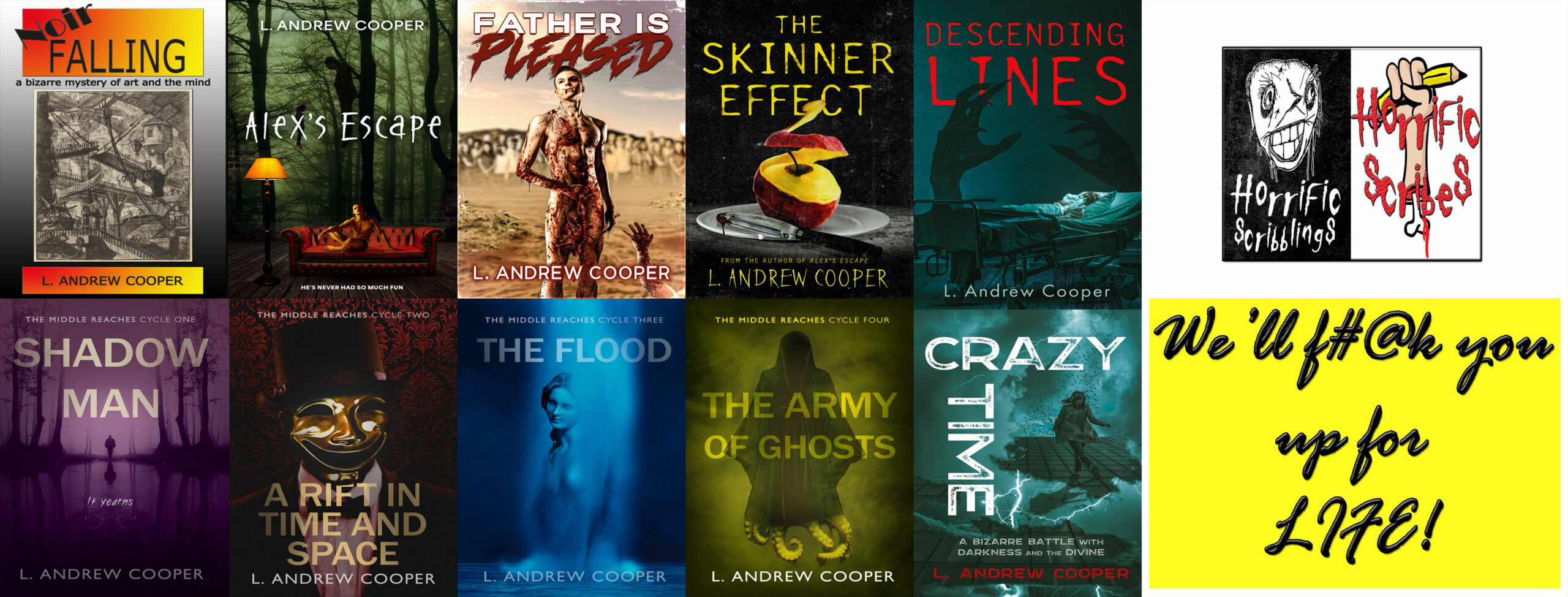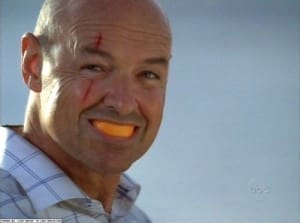The converse is not true, but all monsters are hybrids, or at least John Locke thought so, and although I’d like to believe the human imagination isn’t limited in the way he says it is, I can’t think of a counter-example, and I’ve looked at thousands of variations on monsters and their subtypes around the world.
So last weekend, at the World Horror Convention in Atlanta, BlackWyrm Publishing and I introduced to the world our latest monster!
Go to Amazon to get the marvelous back-cover blurb that co-editor Pamela Turner crafted, but the monstrous gist is that it’s a book about film infecting the world with dark realities, so while we’ve got comedy, western, sci-fi, and, yes, horror, the bottom line is that it’s dark and smart and full of fresh voices and some amazing pros. Hal Bodner! James Chambers! James Dorr! JG Faherty! Amy Grech! Jude-Marie Green! Karen Head! Lots of other great people–accomplished poets, storytellers, and filmmakers as well–and I am honored to be in their company and to have had an opportunity to work with their words, to arrange them so that they can have conversations you can now overhear.

To round out this post, here’s my intro to the volume:
“The film delivers baroque art from its convulsive catalepsy. Now, for the first time, the image of things is likewise the image of their duration, change mummified, as it were.”
—André Bazin, What is Cinema?
“The cinema combines, perhaps more perfectly than any other medium, two human fascinations: one with the boundary between life and death and the other with the mechanical animation of the inanimate… the answer to the question ‘what is cinema?’ should also be death 24 times a second.”
—Laura Mulvey, Death 24x a Second
These two quotations—from two of the most important thinkers about the cinema since mad scientists pieced it together from other art-forms in the late nineteenth century—tell us that even in the silent era that so few horror fans pay due, people saw a close connection between reels of film and the realities of horror and death. Our mission as editors was to find stories that offered dark, diverse perspectives on how far that connection between reel and real might go, and we wanted diversity in both the types of films people wrote about and in the writing itself. Rose Streif attends to the silent era’s neglect by horror’s mainstream in “Caligarisme,” and in addition to The Cabinet of Dr. Caligari (1919/1920), my own movie-obsessed madman narrator in “Leer Reel” riffs on many a silent: he jumps in time but has 1928 as home base. Arguably the first horror film, “The Execution of Mary, Queen of Scots,” made by Thomas Edison’s studio the year regarded as cinema’s beginning, 1895, is just a few short seconds of a woman guillotined. The other contender for first horror film, Georges Méliès’s 1896 “Mansion of the Devil” (or “House of the Devil” if you want Ti West continuity) focuses on magical apparitions. People understood at the outset that just as the photographed, moving image made an action immortal, the immortality was “change mummified,” the immortality of the undead, and, as our debut poet Caroline Shriner-Wunn writes in “Confessions of a Woman of a Certain Age,” “The Mummy,” and some others we’ve scattered in between, the undeadness of the film real is not likely to be your sparkling friend. Think about a movie from 1900. Every frame that shows you a person is showing you a corpse. That person is dead. Chances are, if you’re my age, that person’s corpse looks younger than you do. And it’s smiling. Film, on average, advances at 24 images, or frames, per second. Those corpses are smiling at you 24 times per second. Cheeky bastards.
We selected stories that are dark (that was the point), so though we’ve got laughs and action and western and sci-fi and twisted relationships and WTFs, along with some light as well as extreme horror, expect chills, smart ones, as a thread. Our featured story, Hal Bodner’s “Whatever Happened to Peggy… Who?,” is fast, fun, and creepy on its own, but it pays double if you know mid-20th century American and British horror movies, quintuple if you’ve not only seen but really know Whatever Happened to Baby Jane? (1962), with bonuses if you know The Bad Seed (1956) or a lot of what Bette Davis and Joan Crawford were up to around then. Likewise, Jude-Marie Green’s “Queen of the Death Scenes” harkens to an age of screen queens that is behind us. Pamela Turner’s “Rival” riffs on 40s and 50s film noir with a twist; James Dorr’s title “Marcie and Her Sisters” points toward prime late 70s and 80s Woody Allen, but this editor’s opinion is that, intentionally or not, he manages in Jane Austen comic-horror adaptation territory better than many recent adapters have in several media. Sean Eads also takes us toward more contemporary territory with “The Dreamist,” on the Inception (2010) side of the postmodern mind-game.
Wait! Stop worrying! This ain’t a history book.
We offer you three sections, mostly short stories, with short poems providing different sorts of pleasure scattered in each of the three. Many selections could appear in more than one section,so we placed based on where we thought they leaned.
Part 1 is “Decaying Celluloid,” and selections here either center on specific films or specific genres. In addition to the stories by Bodner, Turner, Dorr, and Streif, you’ll find Shriner-Wunn’s “Last Show at Hobb’s End” especially meaningful if you’ve seen John Carpenter’s Lovecraftian In the Mouth of Madness (1994). Prepare yourself for a story that matches the inversion in the title of Jason S. Walters’s swan song to the classic Western “Low Midnight” (which makes me want to discuss post-Kurosawa samurai films with him… Walters understands bleak but doesn’t present it like Sam Peckinpah or even Sergio Leone). The section concludes with our featured poem, the inimitable Karen Head’s “Amnesia,” a layered reflection on watching/living David Lynch’s Mulholland Drive (2001).
Part 2, “Framing You,” transitions from Head’s poem and focuses on how audiences—the “real” world—might get caught up, often in ways far more literal than most people would think possible, in media. Thinking about Amy Grech’s “Dead Eye” still gives me hills; all I’ll say in an intro is that she derives horrific concepts from the multiple meanings of “frame” and “shot.” Shriner-Wunn’s brief contributions here focus on spectacle, particularly the spectacle of the mutilated woman and what its cultural appeal seems to say (if you don’t know about it, read the poem once before you web search the real Black Dahlia case). Jay Seate and Mike Watt take us into fictional film production worlds, where films have very different ways of absorbing their makers. Sean Taylor’s “And So She Asked Again,” has maestro Mario Bava’s Black Sunday (1960) and its legendary star Barbara Steele as major references, but it’s about obsession with the power of film more generally… and what it could deliver. Likewise, master storyteller J.G. Faherty concludes the section with a tale about a man who finds immense, horrific power in a camera.
The book concludes with Pt. 3, “Pathological Projections,” the smallest and likely weirdest group, as their uniting feature is that they take a (usually kind of abstract) aspect of the medium of film itself and expand it into a (generally fairly messed up) story. Russ Bickerstaff kicks it off with ruminations on the 24-per-second concept in the dark sci-fi “24 per second: Persistence of Fission.” James Chambers suggests the medium may be the monster in “The Monster with My Fist for Its Head,” and in “Queen of the Death Scenes,” Jude-Marie Green finds that manipulating the medium’s immortal qualities could have unwanted side effects Shriner-Wunn’s “The Mummy” recalls Bazin but again goes fuller monster; “Cigarette Burns” by Jay Wilburn finds a perspective on the horror of being in the movies that nothing else I’ve read captures in the same way. My own story… well… it’s last. You get your money’s worth without it. You don’t have to read it. Perhaps you shouldn’t. The narrator is looking at you while you read.
—L. Andrew Cooper
April, 2015



Comments are closed.